Level Mountain
| Level Mountain | |
|---|---|
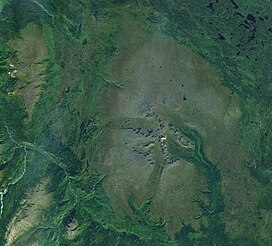 Satellite image of Level Mountain (middle-right) and Heart Peaks (upper-left corner). This image is approximately 80 km (50 mi) east–west. | |
| Highest point | |
| Peak | Meszah Peak[1][2] |
| Elevation | 2,164 m (7,100 ft)[1][2] |
| Listing | Mountains of British Columbia |
| Coordinates | 58°28′43″N 131°26′14″W / 58.47861°N 131.43722°W[1][3] |
| Dimensions | |
| Length | 70 km (43 mi)[4] |
| Width | 45 km (28 mi)[4] |
| Area | 1,800 km2 (690 sq mi)[5] |
| Volume | 860 km3 (210 cu mi)[5] |
| Geography | |
| Country | |
| Age of rock | Less than 15 million years old[10] |
| Type of rock | Alkali basalt, ankaramite, trachyte, rhyolite, phonolite[11] |
| Volcanic region | Northern Cordilleran Province[12] |
| Last eruption | Unknown[6] |
Level Mountain is a large
The mountain began forming about 15 million years ago and has experienced volcanism up until geologically recent times. There have been four stages of activity throughout the long volcanic history of Level Mountain. The first stage commenced 14.9 million years ago with the eruption of voluminous lava flows; these created a large shield volcano. The second stage began 7.1 million years ago to form a structurally complicated stratovolcano located centrally atop the shield. A series of lava domes was established during the third stage, which began 4.5 million years ago. This was followed by the fourth and final stage with the eruption of lava flows and small volcanic cones in the last 2.5 million years. A wide range of rock types were produced during these stages, namely ankaramites, alkali basalts, trachybasalts, mugearites, hawaiites, phonolites, trachytes and rhyolites. Alkali basalts and ankaramites are the most voluminous and form most of Level Mountain. The remaining rock types are less extensive and are largely restricted to the central region of the volcanic complex. Several types of volcanic eruptions produced these rocks.
Level Mountain lies in one of many
Geography and geomorphology
Structure
Level Mountain has a volume of 860 cubic kilometres (210 cubic miles) and an area of 1,800 square kilometres (690 square miles), although at least one estimate of its areal extent is as much as 3,000 square kilometres (1,200 square miles).[4][5] Because of its great extent Level Mountain can be seen from outer space. This, coupled with snow and elevation, helps define the geology of the region.[5] Level Mountain dominates the Nahlin Plateau, a subdivision of the larger Stikine Plateau.[2][13]
Level Mountain comprises two principal components: a voluminous basal shield volcano and an overlying eroded stratovolcano.
From an elevation of 1,400 metres (4,600 feet) onwards the overlying stratovolcano is dominant.[9] Ridges and peaks prevail at an elevation of 1,520 metres (4,990 feet) and comprise the Level Mountain Range.[16][17] These rise more steeply to 1,980 metres (6,500 feet), eventually reaching the highest point of 2,164 metres (7,100 feet) at Meszah Peak.[1][2][6][16] Therefore, when viewed from a distance, Level Mountain appears unusually flat except for a number of black peaks on its summit which have the appearance of enormous volcanic cones.[18]
Biogeography
Level Mountain is in the
The Stikine Plateau Ecosection is one of seven ecosections comprising the
Plants

Level Mountain is characterized by three biophysical zones. The first zone, below an elevation of 1,200 metres (3,900 feet), is predominated by vegetation of the Pinaceae and Betulaceae families. Lodgepole pine is associated with communities of kinnikinnick, bog birch, Altai fescue and moss. Mature white spruce and lodgepole pine forests dominate north of Level Mountain where bog birch occurs in river valley bottoms.[24]
The second biophysical zone lies between elevations of 1,200 and 1,540 metres (3,940 and 5,050 feet).
The third biophysical zone consists largely of an
Animals
The area contains a caribou herd that is part of a larger population extending west of the
Soils
A variety of soil types with differing physical properties are found at Level Mountain. Shallow, coarse, textured and steep to strongly sloping soils dominate peaks of the Level Mountain Range and owe their origin to weathering of volcanic rocks. These well-drained soils are strongly
Climate
The climate of Level Mountain is influenced by the presence of the Coast Mountains to the west, which disrupt the flow of the prevailing westerly winds. This disruption causes the winds to drop most of their moisture onto the western slopes of the Coast Mountains before reaching the Nahlin Plateau, casting a rain shadow over Level Mountain. Because the mountain has a gently sloping and flat profile, it has subtle differences in climate, particularly at the low to upper-mid elevations. Therefore, a relatively homogeneous climate extends over Level Mountain; only gradual temperature and precipitation gradients occur altitudinally.[13] As a result, the mountain lacks a wide diversity of local climates for large mammals.[29]
Travel from high to low elevations below 1,700 metres (5,600 feet) in the winter can be difficult for some mammals due to the accumulation of snow. Above 1,700 metres (5,600 feet), exposure to local winds is improved and ridges of snow are cleared on steeper slopes.[29] Wind speeds increase with elevation but the distribution of wind over the area is fairly uniform.[13] Level Mountain experiences relatively light snowfall unlike the Coast Mountains.[5]
During the late May and early June calving season, winds predominate from a southerly quadrant. Calm conditions are infrequent and average monthly wind speeds are on the order of 3 to 4 metres (9.8 to 13.1 feet) per second. At an elevation of 1,370 metres (4,490 feet), there is a 15–20% chance that precipitation will occur as snow; that probability increases with altitude. Mixed rain and snow are common at that time of the year. Reduced air drainage, coupled with clear calm nights, lowers minimum temperatures in the summer, reducing the frost-free period.[13]
Drainage
The southern and eastern sides of Level Mountain are drained by streams within the
The northern and western sides of Level Mountain are drained by streams within the Nahlin River watershed.[30] To the west, the Dudidontu River flows to the northwest and gathers one named tributary draining the western side of Level Mountain.[31][41] This tributary, Kakuchuya Creek, flows to the north and gathers Matsatu Creek which flows to the northwest from the western side of Level Mountain where it has cut a large steep-sided gorge into the western escarpment.[31][42][43][44] The Koshin River flows to the north from the western side of Level Mountain and gathers two named tributaries.[31][45] These two tributaries, Lost Creek and Kaha Creek, also drain the western side of Level Mountain and flow to the northwest and west, respectively.[31][46][47] The only named stream draining the northern side of Level Mountain is Megatushon Creek which flows to the north.[31][48]
The southwestern side of Level Mountain is drained by streams within the Sheslay River watershed.[30] Egnell Creek is the only named stream in this watershed draining Level Mountain.[31] It flows southwest into the mouth of the Hackett River just above the junction with the Shesley River.[49]
Glaciology
Intense glaciation has taken place at Level Mountain in the last 5.33 million years, as shown by the presence of strongly developed
Geology
Background
Level Mountain is part of the
Level Mountain is part of a subdivision of the NCVP called the Stikine Subprovince. This subprovince, confined to the Stikine region of northwestern British Columbia, consists of three other volcanic complexes: Heart Peaks, Hoodoo Mountain and Mount Edziza. The four complexes differ petrologically and/or volumetrically from the rest of the NCVP. Heart Peaks, Level Mountain and Mount Edziza are the largest NCVP centres by volume, the latter two of which have experienced volcanism for a much longer timespan than any other NCVP centre. Level Mountain, Hoodoo Mountain and Mount Edziza are the only NCVP centres that contain volcanic rocks of both mafic[d] and intermediate to felsic[e] composition.[57] The highest of the four complexes is Mount Edziza at 2,786 metres (9,140 feet), followed by Level Mountain at 2,164 metres (7,100 feet), Heart Peaks at 2,012 metres (6,601 feet) and Hoodoo Mountain at 1,850 metres (6,070 feet).[6][58][59][60]
Composition
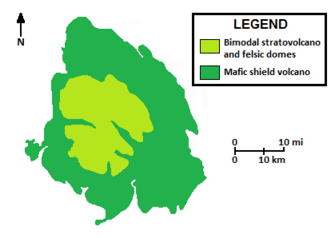
Several rock types with varying chemical compositions make up Level Mountain. Ankaramites and alkali basalts are the main volcanic rocks comprising the basal shield. Alkali basalts form
Basement and faulting
The
Tectonic uplift
Extensive tectonic uplift occurred at Level Mountain and elsewhere on the Stikine Plateau during the Neogene period.[2][17] This resulted in dissection of the plateau surface by stream erosion which varies greatly across the region.[2] The youthful V-shaped gorges along the lava plateau margin of Level Mountain are signs of continuing uplift, which may in part be caused by doming of the mountain during volcanism.[17][50] Several outcrops of alkali basalt south of Kennicott Lake and the Tahltan River are comparable in age to the Level Mountain shield volcano and may represent erosional remnants of this structure.[50]
Volcanic history
Level Mountain is the largest eruptive centre of the MEVC with respect to both volume and area covered.
More than 20 eruptive centres are present on the summit and flanks of Level Mountain.
Mafic shield-building stage

The mafic shield-building stage 14.9 to 6.9 million years ago began with the eruption of thin mafic lava flows over an
Lava flows of the mafic shield-building stage comprise four sub-horizontal units. Initial volcanism produced a 53-metre-thick (174-foot) sequence of columnar-jointed alkali basalt flows and altered grey-green vesicular basalts which form the lowest unit. Subsequent activity deposited the overlying second 107-metre-thick (351-foot) unit. This comprises up to seven 7.6-metre-thick (25-foot) columnar cooling units of alkali basalt separated by buff-weathered vesicular lava flows. Renewed volcanism deposited a 76-metre-thick (249-foot) sequence of massive ankaramite lava flows over the second unit. These lava flows, comprising the third unit, are spheroidally weathered.[p] The mafic shield-building stage culminated with the emplacement of the fourth and highest unit. Eight to ten sequences of columnar-jointed alkali basalt flows comprise this unit and have a total thickness of 122 metres (400 feet).[81] All four sub-horizontal units were deposited over a timespan of eight million years.[5]
Bimodal stratovolcano stage
A second stage of volcanic activity 7.1 to 5.3 million years ago produced peralkaline,
Peralkalinity had remarkable effects on
Felsic dome-forming stage
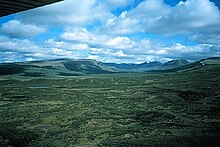
By the
The felsic dome-forming stage extended over a timespan of two million years;[5] Meszah Peak, the highest point of both Level Mountain and the Level Mountain Range, formed at the end of this stage 2.5 million years ago.[2][3][5][86] Also emplaced at the end of this stage were comendite flows, ash flow tuffs and lava tubes.[86]
Quaternary stage
A fourth and final stage of volcanism began on the summit of Level Mountain in the last 2.5 million years, depositing lava in and adjacent to the Level Mountain Range. This lava is indirectly dated as
Two tephra deposits, collectively known as the Finlay tephras, occur in organic-rich mud in the Dease Lake and Finlay River areas.[90] They both range in composition from phonolitic to trachytic and are 5 to 10 millimetres (0.20 to 0.39 inches) thick.[91] Radiocarbon dating of terrestrial plant macrofossils 2 to 2.5 centimetres (0.79 to 0.98 inches) above the youngest tephra deposit suggest an early Holocene age for this volcanic material.[92] Because Level Mountain has received little scientific study, it is a possible source for these tephra deposits along with Hoodoo Mountain, Heart Peaks and the Mount Edziza volcanic complex.[93]
Hazards and monitoring
Like other volcanic centres in the NCVP, Level Mountain is not monitored closely enough by the Geological Survey of Canada to ascertain its activity level. The Canadian National Seismograph Network has been established to monitor earthquakes throughout Canada, but it is too far away to provide an accurate indication of activity under the mountain. It may sense an increase in seismic activity if Level Mountain becomes highly restless, but this may only provide a warning for a large eruption; the system might detect activity only once the mountain has started erupting.[94] If Level Mountain were to erupt, mechanisms exist to orchestrate relief efforts. The Interagency Volcanic Event Notification Plan was created to outline the notification procedure of some of the main agencies that would respond to an erupting volcano in Canada, an eruption close to the Canada–United States border or any eruption that would affect Canada.[95]
The lava plateau margins of Level Mountain are vulnerable to landslides. This is particularly true around the steep south and west plateau boundaries where relatively clay-rich, incompetent layers of agglomerates and tuffs are present between more competent basaltic lava flows. Remnants of a 60,000-cubic-metre (2,100,000-cubic-foot) mudflow are present on the eastern slope of the Little Tahltan canyon. Similar older scars, including those in Beatty Creek, are visible around much of the lava plateau parameter.[28] Past eruptions of Level Mountain may have altered drainage patterns of local streams but their actual effects remain unknown.[96]
Human history
Occupation
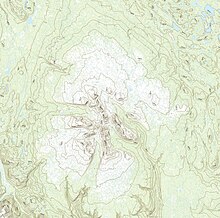
In 1891–1892, the Hudson's Bay Company constructed a trail from the junction of the Sheslay and Hackett rivers to the southwestern slope of Level Mountain.[97] Here, the company had built a trading post by 1898 named Egnell after its operator Albert Egnell.[97][98] After spending one winter at the post, Egnell found that there was no trade to be done in the area and the post was subsequently abandoned. Egnell died on June 22, 1900, from an accidental gun shot to his leg by his son, McDonald, five days earlier and was buried at the Liard Post near the mouth of the Dease River.[99]
In the early 1900s, the Egnell Post served as a repair station for the 3,100-kilometre-long (1,900-mile) Yukon Telegraph Line, which extended from Ashcroft, British Columbia, to Dawson City, Yukon.[98][100] A small settlement consisting of a mission house and a number of other buildings had been established on the site by 1944. This settlement, named Sheslay, has since been abandoned.[98] There is no human population within 30 kilometres (19 miles) of Level Mountain but more than 630 people live within 100 kilometres (62 miles).[6]
Along the south side of Level Mountain are a number of other localities, including Hyland Ranch, Saloon, Salmon Creek Indian Reserve No. 3,
Geological studies
The large size and remote location of Level Mountain has limited geological studies at this volcanic complex.

Level Mountain was demonstrated in the 1920s as a possible source for the extensive lavas in the neighbouring
The mountain was identified by the mapping program of Operation Stikine in 1956.[109] This program, masterminded by Canadian volcanologist Jack Souther, was carried out over the Stikine River area using a Bell helicopter.[109][110] Reconnaissance mapping in 1962 by Jack Souther and Hu Gabrielse identified a sequence of lavas of late Tertiary to Quaternary age.[78] Level Mountain was then studied by T. S. Hamilton in the 1970s who produced a detailed map and the first petrochemical study of the lavas.[86] The andesites described in the 1920s were mapped as early Tertiary age, long before Level Mountain formed.[83] Hamilton recognized the four distinctive stratigraphic units of the lava plateau, as well as the overlying bimodal package of alkali basalt and peralkaline lavas and tuffs.[86]
In 1994, Carignnan et al. considered Level Mountain to be underlain by a
Naming
The name of the mountain is a reference to its plateau surface.
Accessibility
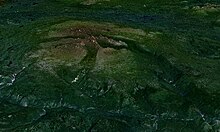
Level Mountain lies in a remote location with no established road access.[4] The closest route to this major volcanic complex is a graded road from Dease Lake to Telegraph Creek, which extends within 50 kilometres (31 miles) of the mountain.[4][114] From Telegraph Creek or Days Ranch the mountain may be reached by a 30-kilometre-long (19-mile) hike.[17] Several small low-lying lakes surrounding Level Mountain provide float plane access, including Ketchum Lake, Hatin Lake and Granite Lake.[4][17]
The Yukon Telegraph Trail, a historic pathway built in the 1890s, is still passable through Hatin Lake and provides an overland route to the shield volcano.[4] Alternatively, fixed-wing aircraft landings can be made on a runway at Sheslay. Charter helicopter service in the small community of Dease Lake provides direct access to the Level Mountain Range.[17] The alpine lava plateau of Level Mountain is easily travelled by horse or on foot during the snow-free period from June to September. Much of the area south of Level Mountain is impassable due to poorly-drained fens.[4]
See also
Notes
- ^ Nivation is erosion caused by freezing and thawing due to snow.[51]
- soil creep caused by waterlogged soil slowly moving downhill on top of an impermeable layer.[52]
- ^ Peralkaline rocks are magmatic rocks that have a higher ratio of sodium and potassium to aluminum.[54]
- ^ Mafic pertains to magmatic rocks that are relatively rich in iron and magnesium, relative to silicon.[56]
- ^ A dike is a sheet-shaped intrusion of magma into pre-existing rock.[61]
- ^ Welded tuff is a volcanic deposit composed of consolidated ash that has been hardened by hot gases, the action of heat and pressure from overlying material.[62]
- ^ Laccoliths are subterranean magmatic bodies that have uplifted overlying rocks while in a molten state.[63]
- ^ Agglomerate is a mass of angular volcanic fragments united by heat.[64]
- ^ Pumiceous pertains to the texture of pumice, which is characterized by several small cavities that give it a spongy, frothy appearance.[65]
- ^ Trachytic pertains to the texture of trachyte, which is characterized by crystals that show parallel alignment due to flow in the magma.[66]
- ^ Tuffaceous pertains to sediments which contain up to 50% tuff.[74]
- ^ Glacial erratics are glacially deposited rocks differing from the size and type of rock native to the area in which they rest.[75]
- ^ An outlier is an area of younger rock completely surrounded by older rocks.[76]
- ^ Siliceous sinter is a deposit of porous silica that forms around hot springs or geysers.[77]
- ^ Spheroidal weathering is a form of chemical weathering that results in the formation of concentric or spherical layers of decayed rock.[80]
- ^ Calc-alkaline pertains to magmatic rocks consisting of 55–61% silica.[84]
- ^ Volcanic bombs are rock fragments larger than 64 millimetres (2.5 inches) in diameter which form when a volcano ejects viscous fragments of lava during an eruption.[88]
- ^ Porphyritic pertains to the resemblance of porphyry which are magmatic rocks consisting of large crystals in a fine-grained matrix.[104]
- ^ The matrix is fine-grained background material in which large grains of a rock are embedded.[105]
- ^ Intrusives are rocks forced while in a molten state into cracks or layers of other rocks.[106]
- ^ Mantle plumes are large columns of hot rock rising through the mantle.[111]
- ^ Hotspots are volcanic regions thought to be fed by underlying mantle that is anomalously hot compared with the surrounding mantle.[111]
References
- ^ a b c d "Level Mountain: Synonyms & Subfeatures". Global Volcanism Program. Smithsonian Institution. Archived from the original on 2021-06-04. Retrieved 2021-06-04.
- ^ OCLC 601782234. Archived from the original(PDF) on 2018-11-14.
- ^ a b "Meszah Peak". BC Geographical Names. Retrieved 2017-01-15.
- ^ a b c d e f g h i j k Fenger et al. 1986, p. 2.
- ^ a b c d e f g h i j k l Wood & Kienle 1990, p. 121.
- ^ a b c d e f g "Level Mountain: General Information". Global Volcanism Program. Smithsonian Institution. Archived from the original on 2021-08-17. Retrieved 2024-01-30.
- ^ Fenger et al. 1986, p. 19.
- ^ a b c d e f g "Level Mountain Range". BC Geographical Names. Archived from the original on 2019-02-23. Retrieved 2024-01-30.
- ^ a b c d Wood & Kienle 1990, pp. 121, 123.
- ^ a b c Edwards & Russell 2000, p. 1283.
- ^ Hamilton & Scarfe 1977, pp. 429, 431, 432.
- ^ a b c d e Edwards & Russell 2000, p. 1284.
- ^ a b c d Fenger et al. 1986, p. 20.
- ^ Fenger et al. 1986, p. 11, Summary.
- ^ Fenger et al. 1986, pp. 2, 20.
- ^ a b c d e f g h i j k Fenger et al. 1986, p. 11.
- ^ a b c d e f g h i j k l m n o p q r s t u Wood & Kienle 1990, p. 123.
- ^ OCLC 982768769.
- ^ Demarchi 2011, p. 147.
- ^ a b Demarchi 2011, p. 148.
- ^ Demarchi 2011, pp. 147, 148.
- ^ Demarchi 2011, pp. 143–147.
- ^ Demarchi 2011, p. 143.
- ^ a b c d Fenger et al. 1986, p. 13.
- ^ Fenger et al. 1986, pp. 13, 14.
- ^ a b Fenger et al. 1986, p. 14.
- ^ "Caribou". American Museum of Natural History. Archived from the original on 2021-03-03. Retrieved 2021-07-11.
- ^ a b Fenger et al. 1986, p. 12.
- ^ a b Fenger et al. 1986, p. 21.
- ^ .
- ^ Department of Energy, Mines and Resources. 1977. Archived from the originalon 2021-05-02. Retrieved 2021-08-14.
- ^ "Little Tahltan River". BC Geographical Names. Retrieved 2023-12-21.
- ^ "Bear Creek". BC Geographical Names. Retrieved 2023-12-21.
- ^ "Beatty Creek". BC Geographical Names. Retrieved 2023-12-21.
- ^ "Middle Creek". BC Geographical Names. Retrieved 2023-12-21.
- ^ "Riley Creek". BC Geographical Names. Archived from the original on 2021-08-13. Retrieved 2023-12-21.
- ^ "Hartz Creek". BC Geographical Names. Archived from the original on 2021-08-13. Retrieved 2023-12-21.
- ^ "Little Tuya River". BC Geographical Names. Archived from the original on 2021-08-13. Retrieved 2023-12-21.
- ^ "Mansfield Creek". BC Geographical Names. Archived from the original on 2021-08-13. Retrieved 2023-12-21.
- ^ "Classy Creek". BC Geographical Names. Archived from the original on 2021-08-13. Retrieved 2023-12-21.
- ^ "Dudidontu River". BC Geographical Names. Archived from the original on 2021-08-13. Retrieved 2023-12-21.
- ^ "Kakuchuya Creek". BC Geographical Names. Archived from the original on 2021-08-13. Retrieved 2023-12-21.
- ^ "Matsatu Creek". BC Geographical Names. Archived from the original on 2021-08-12. Retrieved 2023-12-21.
- ^ a b
 This article incorporates text from this source, which is in the public domain: Annual Report of the Department of the Interior for the Year 1896 (Report). Department of the Interior. 1897. pp. 108, 109.
This article incorporates text from this source, which is in the public domain: Annual Report of the Department of the Interior for the Year 1896 (Report). Department of the Interior. 1897. pp. 108, 109.
- ^ "Koshin River". BC Geographical Names. Archived from the original on 2021-08-13. Retrieved 2023-12-21.
- ^ "Lost Creek". BC Geographical Names. Archived from the original on 2021-08-13. Retrieved 2023-12-21.
- ^ "Kaha Creek". BC Geographical Names. Archived from the original on 2021-08-13. Retrieved 2023-12-21.
- ^ "Megatushon Creek". BC Geographical Names. Archived from the original on 2021-08-13. Retrieved 2023-12-21.
- ^ "Egnell Creek". BC Geographical Names. Archived from the original on 2021-08-13. Retrieved 2023-12-21.
- ^ ISBN 0-660-17610-6.
- S2CID 54817104.
- ISBN 978-0-444-63369-9.
- ^ Edwards & Russell 2000, pp. 1280, 1281, 1283, 1284.
- ^ Imam 2003, p. 253.
- ^ Edwards & Russell 2000, p. 1280.
- ^ ISBN 978-3-642-11271-3.
- .
- ^ "Mount Edziza". Global Volcanism Program. Smithsonian Institution. Archived from the original on 2021-08-10. Retrieved 2021-08-17.
- ^ "Heart Peaks". Global Volcanism Program. Smithsonian Institution. Archived from the original on 2021-05-02. Retrieved 2021-08-17.
- ^ "Hoodoo Mountain". Global Volcanism Program. Smithsonian Institution. Archived from the original on 2021-03-18. Retrieved 2021-08-17.
- ISBN 978-1-4614-3134-3.
- ^ Imam 2003, p. 395.
- ^ Imam 2003, p. 177.
- ^ Imam 2003, p. 6.
- ^ Imam 2003, p. 281.
- ISBN 0-442-20623-2
- ^ Hamilton & Scarfe 1977, p. 433.
- ^ Edwards & Russell 2000, p. 1287.
- ISBN 978-1-77100-054-3.
- OCLC 41856259.
- ISSN 1911-4850.
- ^ Edwards & Russell 2000, pp. 1283, 1284, 1292, 1293.
- ^ a b Wood & Kienle 1990, p. 122.
- ^ Imam 2003, p. 381.
- ^ Imam 2003, p. 112.
- ^ Imam 2003, p. 235.
- ^ Imam 2003, p. 340.
- ^ ISSN 0956-540X.
- ^ Wood & Kienle 1990, pp. 122, 123.
- ^ Imam 2003, p. 350.
- ^ a b c Hamilton & Scarfe 1977, p. 430.
- S2CID 235128119.
- ^ a b c Hamilton & Scarfe 1977, p. 429.
- ^ Imam 2003, p. 57.
- ^ Wood & Kienle 1990, p. 132.
- ^ OCLC 56011504.
- ^ Morra, F. (1977). Uranium Reconnaissance Program, Northern British Columbia: Tulsequah (104 K), Dease Lake (104 J-K), Atlin (104 N) (PDF) (Report). Government of British Columbia. pp. 18, 19. Archived from the original (PDF) on 2013-05-16.
- ^ Imam 2003, p. 49.
- ^ Mark, David G. (1987). Geophysical report on airborne magnetic and VLF-EM surveys over the Moon Claim Group, Hatchau Lake, Dease Lake Area, Atlin Mining Division, British Columbia (PDF) (Report). Government of British Columbia. p. 6.
- ^ Lakeman et al. 2008, p. 935.
- ^ Lakeman et al. 2008, pp. 935, 938.
- ^ Lakeman et al. 2008, p. 938.
- ^ Lakeman et al. 2008, pp. 939, 940.
- ^ "Monitoring volcanoes". Volcanoes of Canada. Natural Resources Canada. 2009-02-26. Archived from the original on 2011-02-15.
- ^ "Interagency Volcanic Event Notification Plan (IVENP)". Volcanoes of Canada. Natural Resources Canada. 2008-06-04. Archived from the original on 2010-02-21.
- Department of Mines and Resources. p. 14. Archived from the original(PDF) on 2021-09-01. Retrieved 2021-09-07.
- ^ OCLC 1131206258.
- ^ a b c "Sheslay". BC Geographical Names. Archived from the original on 2019-01-23. Retrieved 2024-01-30.
- ^ "Egnell, Albert" (PDF). Archives of Manitoba. 2002. Archived (PDF) from the original on 2019-01-13.
- ISBN 0-9690546-8-8.
- ^ "Days Ranch". BC Geographical Names. Archived from the original on 2021-05-03. Retrieved 2021-05-03.
- ^ Nassar, Hana Mae; Szekeres, Jonathan (2018). "'Our most special place': family's ranch destroyed by wildfire near Telegraph Creek". CityNews. Archived from the original on 2021-05-03.
- ISBN 978-1-107-03739-7.
- ^ Imam 2003, p. 271.
- ^ Imam 2003, p. 197.
- ^ Imam 2003, p. 165.
- .
- ISBN 0-662-42326-7.
- ^ a b "Acceptance of the 1995 Career Achievement Award by Jack Souther" (PDF). Ash Fall. Geological Association of Canada. 1996. p. 3. Archived from the original (PDF) on 2018-12-05.
- ISBN 0-7726-2502-6.
- ^ a b "The source of Yellowstone's heat". United States Geological Survey. 2018. Archived from the original on 2021-08-09. Retrieved 2021-08-16.
- ISSN 1480-3313.
- Department of Mines and Resources. pp. 49, 50. Retrieved 2023-12-20.
- ^ Wood & Kienle 1990, pp. 123, 126.
Sources
- Demarchi, Dennis A. (2011). An Introduction to the Ecoregions of British Columbia (PDF). Government of British Columbia. Archived from the original (PDF) on 2021-05-11. Retrieved 2021-11-12.
- Edwards, Benjamin R.; Russell, James K. (2000). "Distribution, nature, and origin of Neogene–Quaternary magmatism in the northern Cordilleran volcanic province, Canada". ISSN 0016-7606.
- Fenger, M.A.; Eastman, D.S.; Clement, C.J.; Page, R.E. (1986). Caribou habitat use on the Level Mountain and Horseranch Ranges, British Columbia. Wildlife Working Report (Report). ISSN 0831-4330.
- Hamilton, T. S.; Scarfe, C. M. (1977). Report of Activities, Part A. Preliminary Report on the Petrology of the Level Mountain volcanic centre, northwest British Columbia (Report). OCLC 719954886.
- Imam, Naiyar (2003). Dictionary of Geology and Mineralogy. ISBN 0-07-141044-9.
- Lakeman, Thomas R.; Clague, John J.; Menounos, Brian; Osborn, Gerald D.; Jensen, Britta J. L.; Froese, Duane G. (2008). "Holocene tephras in lake cores from northern British Columbia, Canada". ISSN 1480-3313.
- Wood, Charles A.; Kienle, Jürgen (1990). Volcanoes of North America: United States and Canada. ISBN 0-521-43811-X.
External links
- "Level Mountain", Catalogue of Canadian volcanoes, Natural Resources Canada, 2006-02-19

